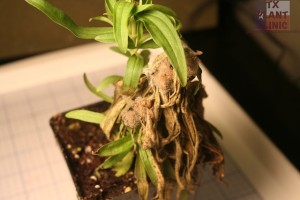 In the cooler months of the year in Texas (Dec – Mar), we typically see an increase in the submission of samples with symptoms of Botrytis blight. This disease is caused by the fungus Botrytis cinerea, and can occur on numerous ornamental plants. Another common name of the disease caused by this fungus is Gray Mold. This disease flares up when conditions are cool and wet (around 55-60 °F), which are typical greenhouse conditions for this time of the year. Interestingly, this is usually not a problem with the homeowner. Guess why? The humidity in the home when it is cooler is usually in the 40-60% range. Furthermore, many people tend to keep their home temperature at or above 72 °F. This is a little too dry for the fungus to run rampant. In many home garden situations, this problem is seen in the later part of the spring or early summer, especially when there are multiple days of rainy and bleak conditions; this can create a conducive environment for this disease to develop.
In the cooler months of the year in Texas (Dec – Mar), we typically see an increase in the submission of samples with symptoms of Botrytis blight. This disease is caused by the fungus Botrytis cinerea, and can occur on numerous ornamental plants. Another common name of the disease caused by this fungus is Gray Mold. This disease flares up when conditions are cool and wet (around 55-60 °F), which are typical greenhouse conditions for this time of the year. Interestingly, this is usually not a problem with the homeowner. Guess why? The humidity in the home when it is cooler is usually in the 40-60% range. Furthermore, many people tend to keep their home temperature at or above 72 °F. This is a little too dry for the fungus to run rampant. In many home garden situations, this problem is seen in the later part of the spring or early summer, especially when there are multiple days of rainy and bleak conditions; this can create a conducive environment for this disease to develop.
Management strategies for this disease include sanitation. Remove and discard blighted flowers or plant parts. Avoid situations which will promote wet conditions (ie. turn sprinklers off when a prolonged cloudy and humid period is expected). There are several fungicides that are effective on Botrytis, but take note that the effectiveness varies greatly depending on the site and type of plant being treated. Fungicide options include both conventional (active ingredient chlorothalonil, etc…) and organic/natural products (neem oil, potassium bicarbonate, etc…). Always read fungicide labels for proper usage. If assistance is needed with understanding fungicide labels, please contact your local AgriLife Extension county office. (local office locator )



